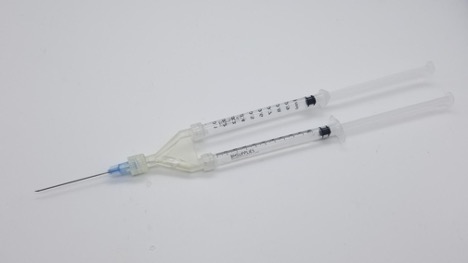Difficulty in injecting multiple drugs to a single injection site
Current devices for injecting multiple drugs to a single target site use a standard y-shaped coupling, with inlets offset by some angle, in which the two drugs to be injected are added in each of the channels, and these two channels are combined into a single channel at the bottom before being fed into the syringe tip. This could cause chemical interaction between the individual fluids before injection, which could lead to undesirable outcomes like precipitation, the release of gases, or the denaturation of biological molecules. The mixing of the injection fluids could also cause skin contact burns while administering the injection.
Multi-channel infusion needle to inject multiple drugs to a single injection site without mixing
Innovators at Georgia Tech have developed an injection device that can deliver a mixture of drugs to a specified target site with a minimally invasive approach. Using this device, multiple fluids can be injected in such a way that they are isolated until the needle’s distal tip. Further, the syringes are aligned in a parallel manner, facilitating ergonomic injection. This fixes the shortcomings of (i) combining multiple channels before feeding it into the needle and preventing the mixing of fluids until the needle’s distal tip as well as (ii) ergonomic alignment of the syringes by enabling parallel alignment. Furthermore, because the syringes and needle can have longer lengths of over one meter, this multi-channel needle can have several clinical uses, including the successful ablation of tumors or use in catheter-based procedures such as cardiac or neurovascular.
- Keeps injection fluids separate: The injected fluids are completely separated until the distal tip of the needle, preventing their mixing until they have reached the syringe tip.
- Reduces dead-volume significantly: Since the specific volumes of each drug required will be added to the channels of the syringe, this device reduces the amount of fluid left in the syringe after injection.
- More convenient injection: The needle allows the clinician to inject with syringes that are parallel to each other, as opposed to at some oblique angle.
- Adaptable length of needle: The length of the device is not limited to the current 1-inch syringe. It can be longer (even greater than 1 meter) for catheter-based procedures.
- Injections of multi-drug infusions.
- Use in catheter-based procedures, using a longer needle.
- Use in tumor ablations.

Image of the Bi-channel Infusion needle
